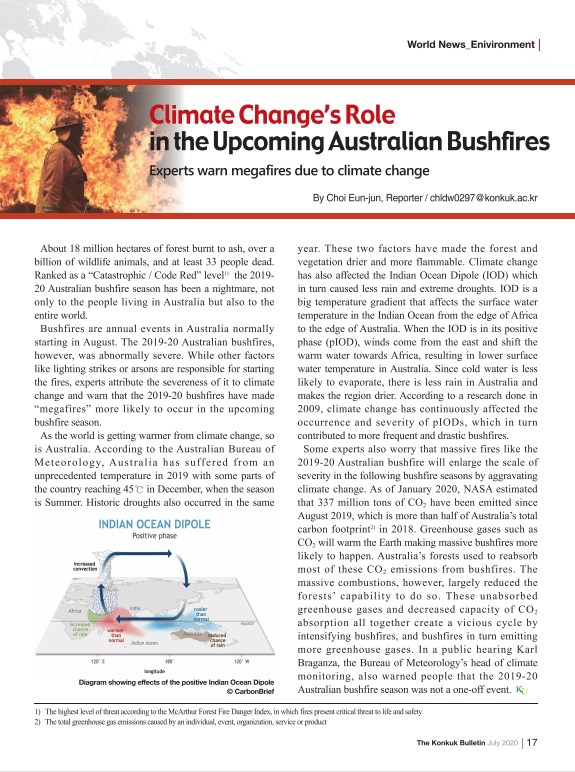Experts warn megafires due to climate change

About 18 million hectares of forest burnt to ash, over a billion of wildlife animals, and at least 33 people dead. Ranked as a “Catastrophic / Code Red” level1) the 2019-20 Australian bushfire season has been a nightmare, not only to the people living in Australia but also to the entire world.
Bushfires are annual events in Australia normally starting in August. The 2019-20 Australian bushfires, however, was abnormally severe. While other factors like lighting strikes or arsons are responsible for starting the fires, experts attribute the severeness of it to climate change and warn that the 2019-20 bushfires have made “megafires” more likely to occur in the upcoming bushfire season.
As the world is getting warmer from climate change, so is Australia. According to the Australian Bureau of Meteorology, Australia has suffered from an unprecedented temperature in 2019 with some parts of the country reaching 45℃ in December, when the season is Summer. Historic droughts also occurred in the same year. These two factors have made the forest and vegetation drier and more flammable. Climate change has also affected the Indian Ocean Dipole (IOD) which in turn caused less rain and extreme droughts. IOD is a big temperature gradient that affects the surface water temperature in the Indian Ocean from the edge of Africa to the edge of Australia. When the IOD is in its positive phase (pIOD), winds come from the east and shift the warm water towards Africa, resulting in lower surface water temperature in Australia. Since cold water is less likely to evaporate, there is less rain in Australia and makes the region drier. According to a research done in 2009, climate change has continuously affected the occurrence and severity of pIODs, which in turn contributed to more frequent and drastic bushfires.
Some experts also worry that massive fires like the 2019-20 Australian bushfire will enlarge the scale of severity in the following bushfire seasons by aggravating climate change. As of January 2020, NASA estimated that 337 million tons of CO2 have been emitted since August 2019, which is more than half of Australia’s total carbon footprint2) in 2018. Greenhouse gases such as CO2 will warm the Earth making massive bushfires more likely to happen. Australia’s forests used to reabsorb most of these CO2 emissions from bushfires. The massive combustions, however, largely reduced the forests’ capability to do so. These unabsorbed greenhouse gases and decreased capacity of CO2 absorption all together create a vicious cycle by intensifying bushfires, and bushfires in turn emitting
more greenhouse gases. In a public hearing Karl Braganza, the Bureau of Meteorology’s head of climate monitoring, also warned people that the 2019-20 Australian bushfire season was not a one-off event.

